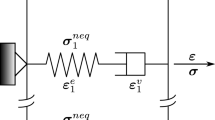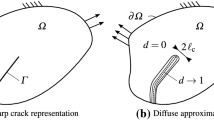Summary
The main objective of the paper is the investigation of localized fatigue fracture phenomena in thermo-viscoplastic flow processes under cyclic dynamic loadings. Recent experimental observations for cycle fatigue damage mechanics at high temperature and dynamic loadings of metals suggest that the intrinsic microdamage process does very much depend on the strain rate and the wave shape effects and is mostly developed in the regions where the plastic deformation is localized. The microdamage kinetics interacts with thermal and load changes to make failure of solids a highly rate, temperature and history dependent, nonlinear process.
A general constitutive model of elasto-viscoplastic damaged polycrystalline solids developed within the thermodynamic framework of the rate type covariance structure with a finite set of the internal state variables is used (cf. Dornowski and Perzyna [16], [17], [18]). A set of the internal state variables is assumed and interpreted such that the theory developed takes account of the effects as follows: (i) plastic nonnormality; (ii) plastic strain induced anisotropy (kinematic hardening); (iii) softening generated by microdamage mechanisms (nucleation, growth and coalescence of microcracks); (iv) thermomechanical coupling (thermal plastic softening and thermal expansion); (v) rate sensitivity; (vi) plastic spin.
To describe suitably the time and temperature dependent effects observed experimentally and the accumulation of the plastic deformation and damage during a dynamic cyclic loading process the kinetics of microdamage and the kinematic hardening law have been modified. The relaxation time is used as a regularization parameter. By assuming that the relaxation time tends to zero, the rate independent elasticplastic response can be obtained. The viscoplastic regularization procedure assures the stable integration algorithm by using the finite difference method. Particular attention is focussed on the well-posedness of the evolution problem (the initial-boundary value problem) as well as on its numerical solutions. The Lax-Richtmyer equivalence theorem is formulated, and conditions under which this theory is valid are examined. Utilizing the finite difference method for a regularized elasto-viscoplastic model, the numerical investigation of the three-dimensional dynamic adiabatic deformation in a particular body under cyclic loading condition is presented.
Particular examples have been considered, namely a dynamic adiabatic cyclic loading process for a thin plate with sharp notch. To the upper edge of the plate is applied a cyclic constraint realized by rigid rotation of the edge of the plate while the lower edge is supported rigidly. A small localized region, distributed asymmetrically near the tip of the notch, which undergoes significant deformation and temperature rise, has been determined. Its evolution until occurrence of fatigue fracture has been simulated.
The propagation of the macroscopic fatigue damage crack within the material of the plate is investigated. It has been found that the length of the macroscopic fatigue damage crack distinctly depends on the wave shape of the assumed loading cycle.
Similar content being viewed by others
References
Abraham, R., Marsden, J. E., Ratiu, T.: Manifolds, tensor analysis and applications. Berlin: Springer 1988.
Agah-Tehrani, A., Lee, E. H., Malett, R. L., Onat, E. T.: The theory of elastic-plastic deformation at finite strain with induced anisotropy modelled isotropic-kinematic hardening. J. Mech. Phys. Solids35, 43–60 (1987).
Armstron, P. J., Frederick, C. O.: A mathematical representation of the multiaxial Bauschinger effect. CEGB Report RD/B/N731, Central Electricity Generating Board, 1966.
Auricchio, F., Taylor, R. L., Lubliner, J.: Application of a return map algorithm to plasticity models. In: COMPLAS Computational Plasticity: Fundamentals and Applications (Owen, D. R. J. and Onate, E. eds.), pp. 2229–2248. Barcelona 1992.
Auricchio, F., Taylor, R. L.: Two material models for cyclic plasticity models: Nonlinear kinematic hardening and generalized plasticity. Int. J. Plasticity11, 65–98 (1995).
Chaboche, J. L.: Time—independent constitutive theories for cyclic plasticity. Int. J. Plasticity2, 149–188 (1986).
Chakrabarti, A. K., Spretnak, J. W.: Instability of plastic flow in the direction of pure shear. Metall. Trans.6A, 733–747 (1975).
Courant, R., Friedrichs, K. O., Lewy, H.: Über die partiellen Differenzgleichungen der Mathematischen Physik. Math. Ann.100, 32–74 (1928).
Curran, D. R., Seaman, L., Shockey, D. A.: Dynamic failure of solids. Physics Reports147, 253–388 (1987).
Dafalias, Y. F.: Corotational rates for kinematic hardening at large plastic deformations. J. Appl. Mech.50, 561–565 (1983).
Dafalias, Y. F., Popov, E. P.: A model of nonlinearly hardening materials for complex loading. Acta Mech.21, 173–192 (1975).
Dafalias, Y. F., Popov, E. P.: Plastic internal variable formalism of cyclic plasticity. J. Appl. Mech.43, 645–651 (1976).
Dautray, R., Lions, J.-L.: Mathematical analysis and numerical methods for science and technology. Vol. 6: Evolution problems II. Berlin: Springer 1993.
Dornowski, W.: Influence of finite deformation on the growth mechanism of microvoids contained in structural metals. Arch. Mech.51, 71–86 (1999).
Dornowski, W.: An algorithm of numerical integration for thermo-elasto-viscoplastic constitutive equations. Biul. WAT3, 31–49 (2000).
Dornowski, W., Perzyna, P.: Constitutive modelling of inelastic solids for plastic flow processes under cyclic dynamic loadings. ASME J. Eng. Materials Technology121, 210–220 (1999).
Dornowski, W., Perzyna, P.: Numerical solutions of thermo-viscoplastic flow processes under cyclic dynamic loadings. In: Proc. Euromech Colloquium 383, Inelastic analysis of structures under variable loads: theory and engineering applications (Weichert, D., ed.) Dordrecht: Kluwer Academic Publishers 1999.
Dornowski, W., Perzyna, P.: Localization phenomena in thermo-viscoplastic flow processes under cyclic dynamic loadings. Computer Ass. Mech. Engng Sci.7, 117–160 (2000).
Durran, D. R.: Numerical methods for wave equations in geophysical fluid dynamics. New York: Springer 1999.
Duszek, M. K., Perzyna, P.: On combinded isotropic and kinematic hardening effects in plastic flow processes. Int. J. Plasticity7, 351–363 (1991).
Duszek, M. K., Perzyna, P.: The localization of plastic deformation in thermoplastic solids. Int. J. Solids Struct.27, 1419–1443 (1991).
Duszek-Perzyna, M. K., Perzyna, P.: Analysis of the influence of different effects on criteria for adiabatic shear band localization in inelastic solids. In: Material instabilities: theory and applications, ASME Congress, Chicago 9–11 November 1994 (Batra, R. C., Zbib, H. M., eds.), AMD-Vol. 183/MD-Vol. 50, pp. 59–85. New York: ASME 1994.
Duszek-Perzyna, M. K., Perzyna, P.: Analysis of anisotropy and plastic spin on localization phenomena. Arch. Appl. Mech.68, 352–374 (1998).
Eftis, J., Nemes, J. A.: Constitutive modelling of spall fracture. Arch. Mech.43, 399–435 (1991).
Gustafsson, B., Kreiss, H. O., Oliger, J.: Time dependent problems and difference methods. New York Wiley 1995.
Hughes, T. J. R., Kato, T., Marsden, J. E.: Well-posed quasi-linear second order hyperbolic system with application to nonlinear elastodynamics and general relativity. Arch. Rat. Mech. Anal.63, 273–294 (1977).
Ionescu, I. R.: Sofonea, M.: Functional and numerical methods in viscoplasticity. Oxford: Oxford University Press 1993.
Johnson, J. N.: Dynamic fracture and spallation in ductile solids. J. Appl. Phys.52, 2812–2825 (1981).
Khan, A. S., Cheng, P.: Study of thress elastic-plastic constitutive models by non-proportional finite deformations of OFHC copper. Int. J. Plasticity6, 737–759 (1996).
Loret, B.: On the effect of plastic rotation in the finite deformation of anisotropic elastoplastic materials. Mech. Mater.2, 287–304 (1983).
Loret, B.: On the effects of plastic rotation on the localization of anisotropic elastoplastic solids. In: Plastic instability, (Salencon J. et al., eds.), pp. 89–100. Paris: Presses Ponts et Chausees 1985.
Lodygowski, T., Perzyna, P.: Localized fracture of inelastic polycrystalline solids under dynamic loading processes. Int. J. Damage Mech.6, 364–407 (1997).
Lodygowski, T., Perzyna, P.: Numerical modelling of localized fracture of inelastic solids in dynamic loading processes. Int. J. Num. Meth. Engng40, 4137–4158 (1997).
Marsden, J. E., Hughes, T. J. R.: Mathematical foundations of elasticity. Englewood Cliffs: Prentice-Hall 1983.
Mroz, Z.: On the description of anisotropic workhardening. J. Mech. Phys. Solids15, 163–175 (1967).
Nemes, J. A., Eftis, J.: Constitutive modelling on the dynamic fracture of smooth tensile bars. Int. J. Plasticity9, 243–270 (1993).
Oldroyd, J.: On the formulation of rheological equations of state. Proc. Roy. Soc. (London)A 200, 523–541 (1950).
Perzyna, P.: The constitutive equations for rate sensitive plastic materials. Quart. Appl. Math.20, 321–332 (1963).
Perzyna, P.: Fundamental problems in viscoplasticity. Adv. Appl. Mech.9, 343–377 (1966).
Perzyna, P.: Thermodynamic theory of viscoplasticity. Adv. Appl. Mech.11, 313–354 (1971).
Perzyna, P.: Constitutive modelling of dissipative solids for postcritical behaviour and fracture. ASME J. Eng. Mater. Technol.106, 410–419 (1984).
Perzyna, P.: Internal state variable description of dynamic fracture of ductile solids. Int. J. Solids Struct.22, 797–818 (1986).
Perzyna, P.: Constitutive modelling for brittle dynamic fracture in dissipative solids. Arch. Mech.38, 725–738 (1986).
Perzyna, P.: Influence of anisotropic effects on micro-damage process in dissipative solids. In: Yielding, damage and failure of anisotropic solids., Proc. IUTAM/ICM Symposium Villerd-de-Lance, August 1987, (Boehler, J. P., ed.), pp. 483–507. London: Mech. Eng. Publ. 1990.
Perzyna, P.: Instability phenomena and adiabatic shear band localization in thermoplastic flow processes. Acta Mech.106, 173–205 (1994).
Perzyna, P.: Interactions of elastic-viscoplastic waves and localization phenomena in solids. In: Nonlinear Waves in Solids. Proc. IUTAM Symposium, August 15–20, 1993, Victoria, Canada, (Wegner, L. J., Norwood, F. R., eds.), pp. 114–121. ASME Book No AMP 137, 1995.
Perzyna, P., Drabik, A.: Influence of thermal effects on micro-damage solids. Arch. Mech.40, 795–805 (1988).
Perzyna, P., Drabik, A.: Description of micro-damage process by porosity parameter for nonlinear viscoplasticity. Arch. Mech.41, 895–908 (1989).
Perzyna, P., Drabik, A.: Micro-damage mechanism in adiabatic processes. Engineering Transactions (forthcoming).
Prager, W.: The theory of plasticity: A survey of recent achievements. (J. Clayton Lecture). Proc. Inst. Mech. Eng.169, 41–57 (1955).
Richtmyer, R. D.: Principles of advance mathematical physics, vol. I. New York: Springer 1978.
Richtmyer, R. D., Morton, K. W.: Difference methods for initial value problems. New York: Wiley 1967.
Ristinmaa, M.: Cyclic plasticity model using one yield surface only. Int. J. Plasticity11, 163–181 (1995).
Shima, S., Oyane, M.: Plasticity for porous solids. Int. J. Mech. Sci.18, 285–291 (1976).
Shockey, D. A., Seaman, L., Curran, D. R.: The microstatistical fracture mechanics approach to dynamic fracture problem. Int. J. Fracture27, 145–157 (1985).
Sidey, D., Coffin, L. F.: Low-cycle fatigue damage mechanisms at high temperature. In: Fatique Mechanisms, Proc. ASTM STP 675 Symposium, Kansas City, Mo., May 1978 (Fong, J. T., ed.), pp. 528–568. ASTM, Baltimore 1979.
Strang, G., Fix, G. J.: An analysis of the finite element method. Englewood Cliffs: Prentice-Hall 1973.
Van der Giessen, E.: Continuum models of large deformation plasticity, Part I: Large deformation plasticity and the concept of a natural reference state. Eur. J. Mech., A/Solids8, 15–34 (1989).
Van der Giessen, E.: Continuum models of large deformation plasticity, Part II. A kinematic hardening model and the concept of a plastically induced orientational structure. Eur. J. Mech., A/Solids8, 89–108 (1989).
Van der Giessen, E.: Micromechanical and thermodynamic aspects of the plastic spin. Int. J. Plasticity7, 365–386 (1991).
Wang, J.-D., Ohno, N.: Two equivalent forms of nonlinear kinematic hardening: application to nonisothermal plasticity. Int. J. Plasticity7, 637–650 (1991).
Ziegler, H.: A modification of Prager's hardening rule. Quart. Appl. Math.17, 55–65 (1959).
Author information
Authors and Affiliations
Rights and permissions
About this article
Cite this article
Dornowski, W., Perzyna, P. Localized fracture phenomena in thermo-visco-plastic flow processes under cyclic dynamic loadings. Acta Mechanica 155, 233–255 (2002). https://doi.org/10.1007/BF01176245
Received:
Issue Date:
DOI: https://doi.org/10.1007/BF01176245




